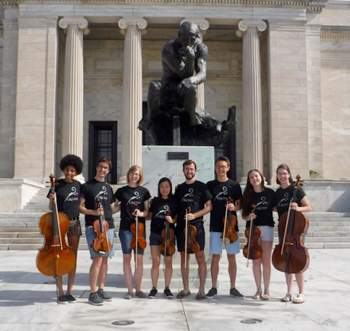by Robert Rollin

According to Peter Slowik, Credo’s Artistic Director, and Oberlin Professor of Viola, Credo’s mission statement is to Develop the gift. Acknowledge the Source. Respond in service. This message of humility, faith, and proactive contribution distinguishes Credo from other festival organizations.
On Friday night, after a light al fresco dinner with several student string quartets performing Mendelssohn, Ravel, and Borodin in various spots around the outdoor gardens, the audience moved indoors to hear the formal 2016 Credo Fellowship Quartets Concert.
The concert centered around the Mendelssohn String Octet in E–flat, Op. 20, and also included three movements from string quartets by Beethoven and Brahms. The evening’s highlight was the Octet, affording the opportunity to hear eight talented students interact in a piece by an ingenious sixteen-year-old composer. One could see and hear the mission statement’s impact on these young artists.
Ann Yu, an Oberlin student, served as principal violin for most of the work. The opening “Allegro moderato con fuoco” is a mini-violin concerto for the principal. Yu negotiated the eighth- and sixteenth-note passages with amazing poise and perfection at break-neck speed. The performance of the more delicately graceful “Andante” was simply gorgeous and had the character of a soulful song.
The players switched parts in the last two movements, displaying their versatility and cooperative spirit. Jordan Hendy, a junior from Juilliard, impressively took over as principal violin for these two movements. The talented violist Josephine Stockwell also moved to the principal quartet.
Mendelssohn wrote to his sister that the Scherzo’s opening motto theme paralleled the following words from Goethe’s Faust: “Trails of cloud and mist brighten from above; breeze in the foliage and wind in the reeds – and everything is scattered.” The interplay of the strings creates a kaleidoscope of changing tone color that is most effective if the entire movement is pianissimo, as requested by the composer. The performance was nothing short of remarkable.
The Finale “Presto” is a perpetuum mobile employing an almost Baroque fugal style in the vein of the finale of Mozart’s “Jupiter” Symphony. After the almost growling start in the cellos, the octet negotiated the hellishly fast tempos with great aplomb. There is an appropriate exuberance in the spinning out of the finale, and the performance was simply stunning.
Two movements from the Beethoven Quartet in G, Op. 18 No. 3 opened the concert. The string quartet led by Ann Yu performed the opening “Allegro” and the “Scherzo.” The first movement afforded Yu many attractive solos. Christa Cole switched to principal for the Scherzo, which has a lovely fugato that the ensemble gave great dynamic variety.
The second quartet, led by Jordan Hendy, performed the first movement of Brahms’s String Quartet in c, Op. 51, No.1. Brahms said he could “hear the footsteps of Beethoven,” and waited until he was 40 to release his first quartet and first symphony. The performers had a colorful sound and the final intense ritardando was especially effective.
Most importantly, the gifted performers showed a cooperative and collegial attitude toward one another, changing parts with grace, and maintaining an impressive professionalism. Clearly the Credo program is working!
Published on ClevelandClassical.com July 26, 2016.
Click here for a printable copy of this article



